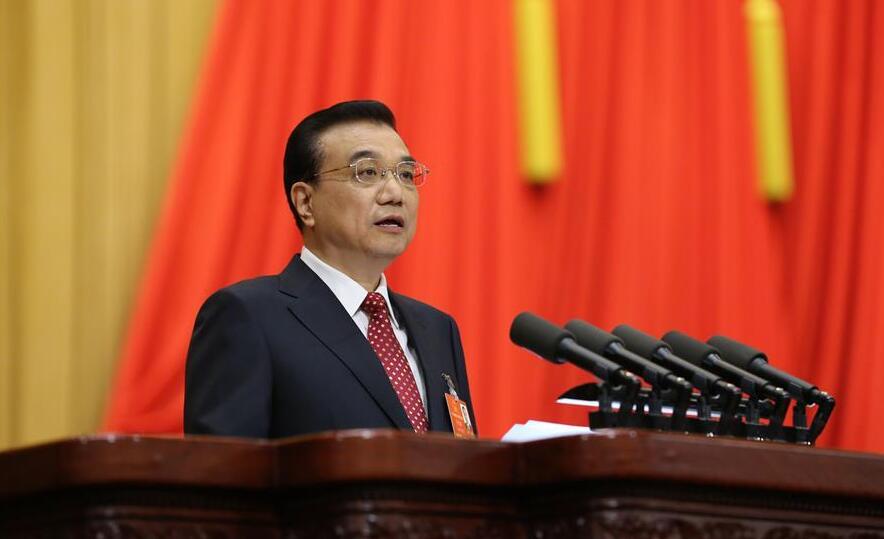China adopts new strategy to refuel growth
 0 Comment(s)
0 Comment(s) Print
Print E-mail Xinhua, March 7, 2016
E-mail Xinhua, March 7, 2016
|
|
|
Chinese Premier Li Keqiang delivers a government work report during the opening meeting of the fourth session of the 12th National People's Congress at the Great Hall of the People in Beijing, capital of China, March 5, 2016. (Xinhua/Liu Weibing) |
Facing downward risks, volatile securities and sluggish manufacturing, China is exploring a new approach to rein in a slowdown and restructure the economy.
"We must work faster to ...carry out supply-side structural reform to improve the quality and efficiency of the supply system, and further stimulate market vitality and the creativity of society," Premier Li Keqiang said Saturday when presenting a government work report to the annual parliamentary session.
A basket of policies was underlined in the report, including more cuts to red tape, support for innovation and entrepreneurship, closure of redundant factories and consolidation of torpid state-owned enterprises.
It was the first time the term "supply-side structural reform" has been included in China's government work report.
"The term's inclusion suggests the government is resolved to propel reform and restructuring," said Liu Zhibiao, a political advisor and economic professor at Nanjing University.
While demand-side management, characterized by investment, consumption and exports, determines short-term growth, measures on the supply side prompt better allocation of resources such as labor, land, capital and innovation, Liu added.
"It lets the market play a decisive role in resource allocation, which had been disturbed by government interference," said Jia Kang, an economist and political advisor.
Proposed at a tone-setting economic work conference in November 2015, supply-side reform aims to create a fertile and fair environment to encourage high-quality goods and services for all players.
Supply-side reform marks the exploration and creation of China's own economic theory, said Wang Yiming, deputy director of the State Council Development Research Center, a government think tank.
Similar policies including tax breaks and fiscal expansion introduced by former U.S. President Ronald Reagan and former British Prime Minister Margaret Thatcher stimulated economic recoveries in their countries.
Economists believe China's version, enriched by more structural adjustments, can ensure sustainable medium-high growth for the economy.
For around three decades, China's miracle was envied and admired by major economies, but a slowdown since the 2008 global financial crisis has left many jittery. Last year's GDP growth slipped to its lowest notch in a quarter of a century.
Given the changing economic landscape, the term "new normal" was adopted by policymakers to describe the present stage of slower but higher quality growth.
"Deceleration has already been a clear fact in the new normal," Jia said. "China has to forge new growth drivers to offset downward pressure."
INNOVATION-DRIVEN DEVELOPMENT
The word "innovation" was mentioned 61 times in the government work report, up from 38 times in last year's version. "Innovation is the primary driving force for development and must occupy a central place in China's development strategy," Li said.
The government will build first-class national science centers and technological innovation hubs, help develop internationally competitive enterprises and accelerate China's transformation into a manufacturer of advanced and quality products, said the report.
By 2020, China's R&D investment will account for 2.5 percent of the GDP, and the contribution of scientific and technological advances toward economic growth will rise to 60 percent.
Confronted with looming downward pressure, China is counting on innovation to assist a shift in economic engines.
"Innovation is the source of corporate profitability," said Yuan Liqun, vice president of home appliance producer Midea Group and deputy to the National People's Congress.
The company boasts industry-leading profitability thanks to its encouragement of creativity in employees, including the 100 million yuan (around 15 million U.S. dollars) it earmarks each year to cover incentives for innovative employees and expenditures for their projects.
Manufacturers must make product innovations meet the needs of consumers and survive competition, Yuan said.
Riding on the wave of innovation, growth companies are on the rise. Chinese homegrown smartphone maker Xiaomi has become rather popular on the market. Mobile apps developed by young innovators offering services ranging from car cleaning to manicures are mushrooming on the Internet.
Emerging industries, such as robotics, intelligent equipment, drones and high-speed railways, are becoming China's new economic engines, analysts said.
The government expects the output of emerging sectors to account for 15 percent of GDP by 2020, up from the current 8 percent.






